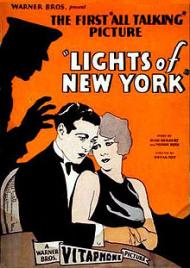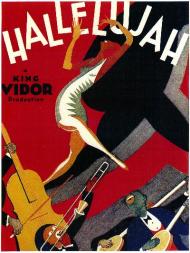Movie Review
The Jazz Singer
MAMMY!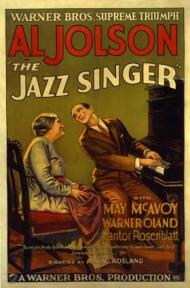
US Release Date: 10-06-1927
Directed by: Alan Crosland
Starring▸▾
- Al Jolson, as
- Jakie Rabinowitz - Jack Robin
- May McAvoy, as
- Mary Dale
- Warner Oland, as
- The Cantor
- Eugenie Besserer, as
- Sara Rabinowitz
- Otto Lederer, as
- Moisha Yudelson
- Robert Gordon, as
- Jakie Rabinowitz - Age 13
- Richard Tucker, as
- Harry Lee
- Cantor Joseff Rosenblatt, as
- Himself - Concert Recital
- Myrna Loy, as
- Chorus Girl
- Roscoe Karns, as
- Agent
- William Demarest as
- Buster Billings
![2.5 star[s] out of 4](http://www.threemoviebuffs.com/static/images/global/featured_gold_stars.png)
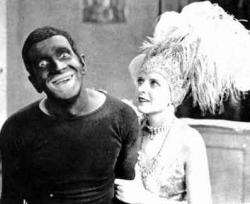
Al Jolson in blackface with May McAvoy in The Jazz Singer.
As the movie that launched the sound era, The Jazz Singer is one of the most historically important films in Hollywood history. As entertainment, however, it is nearly unwatchable today. And despite its reputation it's not really a talkie at all. It's pretty much a silent movie, complete with title cards for dialogue, except for the musical numbers, which must have thrilled audiences of the day. Jolson speaks a few lines of in between song patter – most famously when he exclaims, “Wait a minute, wait a minute, you ain't heard nothin' yet!” The only actual conversation occurs between Jack and his mother while he tickles the ivories at the piano in his parent's apartment.
Before The Jazz Singer there had been several talkie shorts and a few features with synchronized sound. D.W. Griffith's Dream Street had featured a single singing sequence way back in 1921. It was the combination of Jolson's popularity and his style of music - which was the rock n roll of its day - that caused audiences to clamor for more sound movies after October 6, 1927. Although it would take Hollywood's movie studios, and theaters across the country, months to make the switch to sound. For the record the very first all talking feature, Lights of New York, wasn't released until July of 1928. And it wasn't until 1930 that the transition to sound would be complete, with only Charlie Chaplin remaining as the last hold-out from the silent era.
Although he's primarily remembered today for this movie, during the early decades of the 20th Century Al Jolson was the highest paid and most famous entertainer in America. As the first performer to conquer the stage, recordings, the movies and radio, he was the first true superstar. Jolson was 41 when this movie was made; he had been a star since his first sell-out engagement at the Winter Garden in 1911.
Unfortunately his singing style and song choices (you just don't hear “Toot Toot Tootsie” and “Dirty Hands, Dirty Face” being sung anymore) seem hopelessly old-fashioned and corny today. His exaggerated emotionalism is maudlin enough but when he dons blackface to sing “My Mammy” it's positively cringe inducing.
The plot is creaky melodrama. 13-year-old Jakie Rabinowitz, the son of a Jewish cantor living on Manhattan's Lower East Side, gets caught singing jazz songs at a local beer hall. After his father severely chastises him he runs away from home. Years later Jakie – now going by Jack Robin – is an up and coming singer in San Francisco. He meets a girl and she helps him get his big break. Jack eventually makes it to Broadway and reconnects with his parents. At the climax Jack must choose between his Broadway debut and singing at the synagogue for his dying father.
Sharp eyed viewers may spot the beautiful Myrna Loy as a chorus girl. Roscoe Karns and William Demarest both show up in small parts as well. With a total of ten songs performed, The Jazz Singer is the first movie musical. It's a unique hybrid, a sort of silent musical, if you will. As historically important as it is though, it's just not a very good movie.
![3 star[s] out of 4](http://www.threemoviebuffs.com/static/images/global/featured_gold_stars.png)
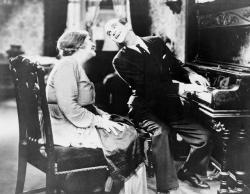
Eugenie Besserer and Al Jolson in The Jazz Singer
As Patrick wrote, Al Jolson was the first rock star. Although his songs and style have long since gone out of fashion, he started a trend of white men emulating black performers. Before Eminem became the first white rapping superstar in the 1990s, before George Michael had the first # 1 CD on the black charts by a white man in the 1980s and before Elvis Presley moved like no white man had done before in the 1950s, Al Jolson took ragtime and jazz music, so dominated by African Americans, and made it acceptable for whites to listen to.
As far as the black face routine goes, it was something Jolson had been doing for some 20 years before this movie was made. Look how he applies it himself with practiced ease. It may look offensive today but from what I read it was not so rude at the time. Remember, this was a white man singing music considered racy. Perhaps he was not sure how he would be perceived being a white man singing black music, so he made the joke obvious before anyone else could point it out.
I once visited the original Motown recording studio in Detroit, which is little more than a home remodeled with a recording studio in the basement. The most shocking thing I learned was that the first Motown records were released with white models on the cover, because it was believed at the time that whites would not be seen buying a record with a black person on the cover. Can we not apply similar logic to Al Jolson trying to be accepted as a white man singing black music?
Jolson wearing black face in this film is so much more than just a gimmick. He wears it for one number and the following dramatic scene. After performing, Jolson walks back stage and is met by his mother whom he has barely seen in the past decade. She stares at him with a look of disgust. She is there to tell him of his estranged father’s condition and finds that her son has not only abandoned his father’s teaching but is now masking himself in shame for money and fame. The face paint is brilliant symbolism of him being a fraud.
The Jazz Singer is a great companion piece to Hallelujah! (1929) Both feature jazz (black) music presented for a wide (white) audience. You may watch either of these films and find offense, but at the time they were groundbreaking. Popular music from any time period is not only the soundtrack to that particular generation; it is the progression from the previous generation and a stepping stone for the next generation of musicians.
In fact, that is very much the theme here with Jack wanting to break away from his roots to explore and exploit the music he loves. The Jazz Singer is very watchable today. What parent has not heard their children’s music and cringed? How many young people have had to hurt their parent’s feelings to do their own thing? Sure this film is remembered for the use of sound but it also tells a timeless tale of a young man seeking happiness at the risk of being ostracized by his family.
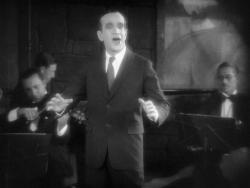
Al Jolson in The Jazz Singer.
The headline in the Los Angeles Times after the premiere of The Jazz Singer read, "'Jazz Singer' Scores a Hit—Vitaphone and Al Jolson Responsible, Picture Itself Second Rate." Almost 90 years later and that description is as accurate now as it was then. Apart from the novelty of the few scenes with sound and the opportunity to see the most popular entertainer of his age, this movie is just your average melodrama.
Jolson's popularity is hard to fathom just from watching this movie almost a century after it was made. His type of singing has long since gone out of style and his acting isn't that great either. He does display an energetic charisma that at least hints at why so many people found him appealing. At his peak, he was the highest-paid entertainer in America. Between 1911 and 1928, he had 9 sell-out shows in New York City's Winter Garden theatre, more than 80 hit records and 16 national and international tours. It's no wonder this movie was a hit, despite the fact that during its initial release, many theaters that showed it, lacked the capability to play the sound elements and so ran a silent version.
When talking about the blackface, I think it's important to consider the time period and the intent. Jolson had been wearing the makeup for most of his career and while it may be inherently racist, at the same time he was making music typically performed by blacks popular among white audiences, which ultimately helped black musicians. And Jolson was well regarded by many in the black community. The Harlem newspaper, The Amsterdam News, called The Jazz Singer, "one of the greatest pictures ever produced." and wrote of Jolson that "Every colored performer is proud of him." The president of the Negro Actors Guild, Noble Sissle, attended Jolson's funeral. Jeni LeGon, a black tap dance star wrote that black cast members of the time never mingled with the whites, but that, "The only ones that ever invited us home for a visit was Al Jolson and Ruby Keeler." Also, as Eric wrote, the blackface serves the story here. Jolson is struggling to decide whether he will perform on stage or in the synagogue. Is he an actor or a Jew first? The blackface, as he stares at himself in the mirror, clearly represents the mask he wears as a performer.
Having part of the film a talkie while the majority is silent may have helped audiences of the day ease into the idea of sound movies, but it's rather jarring watching it today. After the film's only dialogue scene, which ends so dramatically with Jolson's father uttering one word with such finality, you feel the silence and the title cards bearing the dialogue suddenly seem even more archaic than they already did.
Apart from Jolson, the cast brings little to the film. The acting is as hammy as the plot. Eugenie Besserer, as Jolson's dear mother, is the most guilty of the horrible silent film style of acting, but so is almost everyone else to some degree. May McAvoy is cute but bland as the love interest.
Being considered the first talking picture has overshadowed another aspect of this film that had just as long reaching consequences. Prior to this movie, theaters paid a set amount per week to show a movie. With this film Warner Bros. introduced a sliding scale that is still used today. They took a percentage of the box office gross from each theater, with the percentage becoming smaller each week. The longer a film was successful and remained in the same theater, the more the theater earned from it. The impact of that is still being felt today. It explains in part why studios place such a heavy emphasis on opening weekends, because it's that first week where their percentage of the box office is at its highest.
The idea of having the next generation rebelling against the path set out for them by the previous one is timeless, having been done so many times before this movie and again after it, in books, plays, and other movies, including 3 remakes of this exact same story. It's not the best example of that idea though and on its own the plot is completely forgettable. We remember it now because it ushered in the sound era, and while inevitably sound would have happened with or without Jolson, it was his popularity and the popularity of this film that made the transition happen so quickly as theaters rushed to convert to sound so they could show this movie, intact with Jolson's singing, and cash in on its success.
Photos © Copyright Warner Bros. Pictures (1927)

